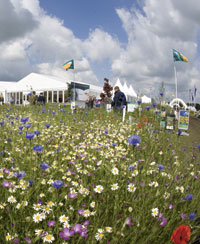Cereals 2010: Growers urged to join CFE

Campaign for the Farmed Environment organisers are hoping that last week’s awareness-building campaign at Cereals 2010 will result in thousands more farmers adding their support to the scheme over the next few months, helping to avoid a return to compulsory set-aside.
To succeed, the CFE, put together by the NFU and other key industry partners and launched last November, must persuade arable farmers across England to adopt a range of measures that will deliver environmental benefits that match those delivered by set-aside.
They have until June 2012 to do so or face a return to an enforced environmental scheme.
Entry Level Stewardship is the key to CFE success. Many agreements are now coming to an end, and according to CFE co-ordinator Corrina Gibbs, nine out of 10 farmers will have to renew if the campaign is achieve its targets (see box). “We are now at the critical stage where we need to see that interest being turned into action.”
She was encouraged by the level of interest shown at Cereals. More than 200 farmers competed a CFE trail, picking up advice and management tips at stands across the event. “Many more will have picked up messages from individual stands or elsewhere – the CFE logo was everywhere,” she added.
About 12,700 ELS agreements are up for renewal this year. Ross Evans of Natural England said that 2500 ELS application forms had been received for the 1 August start date by the beginning of Cereals week. More than 1000 had been processed, which represented about a quarter of all agreements expiring on 31 July.
“I am confident that this, coupled with an element of new farmers coming into the scheme, will help us hit the target of 70% of the useable arable area being in some form of agri-environment scheme by the end of next March,” he said.
Jim Egan, technical director of FWAG and chairman of the CFE delivery group, said the biggest test was now beginning. “Hopefully, Cereals will have given famers a good idea of what the campaign is about. The current renewal rate was encouraging, he added.
But quality, as well as quantity, was important, he said. People needed to ensure they included key target options in their ELS applications. These included extended overwintered stubbles, pollen and nectar mixes and wild bird seed cover.
“If everyone converts the number of points they had invested in management plans, which are now no longer available, then we will hit the 40,000ha target of enhanced environmental options.”
However, some farmers seemed confused by the CFE message. Mr Evans reported several visitors believing it was a separate scheme, and Ms Gibbs said there had been a number of requests for simplified information.
“There is an urgent need to get the message out to farmers. But it was always planned to deliver the message on the ground – with agronomists and advisers playing a key role.”
CFE TARGETS
70% agri-environment coverage of England’s usable agricultural area (UAA) by March 2011
Maintain uncropped land area at 179,000ha
Boost uptake of high quality (in-field) environmental options in ELS by 40,000ha.
Almost one-third of farmers are expected to renew their ELS applications through the improved online system, much higher than anticipated, says Natural England’s Ross Evans.
“It is fantastic to see an ever-growing proportion of farmers and agents applying or renewing their ELS agreements online. It makes the application process quicker and easier for all involved, so it means we can get the scheme set up for the farmer much faster,” he said.
More information at www.wholefarm.defra.gov.uk

